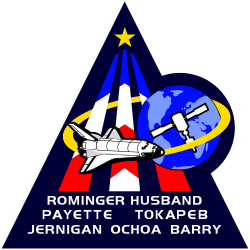Julie Payette
| Julie Payette | |
 Payette 2017 | |
| Född | 20 oktober 1963 Montréal, Québec |
|---|---|
| Tid i rymden | 25 dagar, 11 timmar, 57 minuter |
| Urvalsgrupp | 1992 CSA Group |
| Uppdrag | STS-96, STS-127 |
| Uppdragsemblem | |
Julie Payette, född 20 oktober 1963 i Montréal, är en kanadensisk astronaut som var Kanadas generalguvernör, den 29:e i ordningen, mellan 2017 och 2021. Hon var den fjärde kvinnan och sjätte franskspråkiga personen att inneha det vicekungliga ämbetet.
Biografi
Payette har deltagit i två rymdfärder, STS-96 och STS-127, och har totalt tillbringat mer än 25 dagar i rymden. Hon har tjänstgjort som chefsastronaut för den Canadian Space Agency samt kapselkommunikatör vid Nasas Mission Control Center i Houston.
I juli 2013 utsågs Payette till chief opererating officer vid Montreal Science Center och i april 2014 utsågs hon till ledamot i styrelsen för Kanadas riksbank[1]. Kanadas premiärminister Justin Trudeau föreslog henne till att efterträda David Johnston som generalguvernör under 2017. Payette avgick som generalguvernör 21 januari 2021 sedan en utredning fann att hon bidrog till en dålig arbetsmiljö för dem som arbetade i hennes närhet.[2][3]
Payette har varit gift två gånger och har ett barn.
Eftermäle
Asteroiden 14574 Payette är uppkallad efter henne.[4]
Rymdfärder
Referenser
Noter
- ^ General, Office of the Secretary to the Governor (22 september 2017). ”Biography”. The Governor General of Canada. Arkiverad från originalet den 13 oktober 2020. https://web.archive.org/web/20201013183106/https://www.gg.ca/en/governor-general/governor-general-julie-payette/biography. Läst 14 juni 2019.
- ^ Burke, Ashley (21 januari 2021). ”Payette stepping down as governor general after blistering report on Rideau Hall work environment”. CBC News. https://www.cbc.ca/news/politics/governor-general-payette-step-down-1.5882675. Läst 21 januari 2021.
- ^ The Canadian Press (21 januari 2021). ”What happens when the governor-general resigns?”. The Globe & Mail. https://www.theglobeandmail.com/canada/article-what-happens-when-the-governor-general-resigns-2. Läst 21 januari 2021.
- ^ ”Minor Planet Center 14574 Payette” (på engelska). Minor Planet Center. https://www.minorplanetcenter.net/db_search/show_object?object_id=14574. Läst 15 maj 2024.
Externa länkar
 Wikimedia Commons har media som rör Julie Payette.
Wikimedia Commons har media som rör Julie Payette.
|
Media som används på denna webbplats
Kanadas flagga, införd 1965; denna version med Pantone‐nyanser. Nuvarande utformning ersatte den tidigare kanadensiska Red Ensign.
Författare/Upphovsman: Johanie Maheu, Licens: CC BY-SA 4.0
Julie Payette in 2017 at Rideau Hall.
Space Shuttle mission STS-127 is the 32nd construction flight of the International Space Station (ISS) and the final of a series of three flights dedicated to the assembly of the Japanese "Kibo" laboratory complex. In addition to delivering, installing, and servicing an external scientific platform that will be attached to the end of the Japanese module, STS-127 will bring up a new ISS crew member and return another one to Earth, replace vital components of the ISS electrical production system, and transfer various pieces of hardware to ISS. Five spacewalks and the operation of four different robotic arms will be required to accomplish these tasks over 10 days. A crew spokesperson had the following words for the patch. "Bathed in sunlight, the blue Earth is represented without boundaries to remind us that we all share this world. In the center, the golden flight path of the space shuttle turns into the three distinctive rays of the astronaut symbol culminating in the star-like emblem characteristic of the Japanese Space Agency, yet soaring further into space as it paves the way for future voyages and discoveries for all humankind."
Designed by the crew members, this is the mission insignia for the STS-96 space flight, the second Space Shuttle mission dedicated to the assembly of the International Space Station (ISS). The crew patch highlights the major themes of the Station Program: Earth-directed research, the advancement of human space exploration, and international cooperation. The Space Shuttle Discovery is depicted shortly after reaching orbit as the crew prepares to carry out the first docking with the new Station. At this early stage in its construction, ISS consists of two modules: Zarya and Unity, shown orbiting Earth. The triangular shape of the patch represents building on the knowledge and experience of earlier missions, while the three vertical bars of the astronaut emblem point toward future human endeavors in space. The five-pointed star that tops the astronaut emblem in this depiction is symbolic of the five space agencies participating in the development of ISS: NASA, the Russian Space Agency, the European Space Agency, the National Space Development Agency of Japan, and the Canadian Space Agency. The blend of red, white, and blue is a tribute to the nationalities of the crew members who are from the United States, Canada, and Russia.



